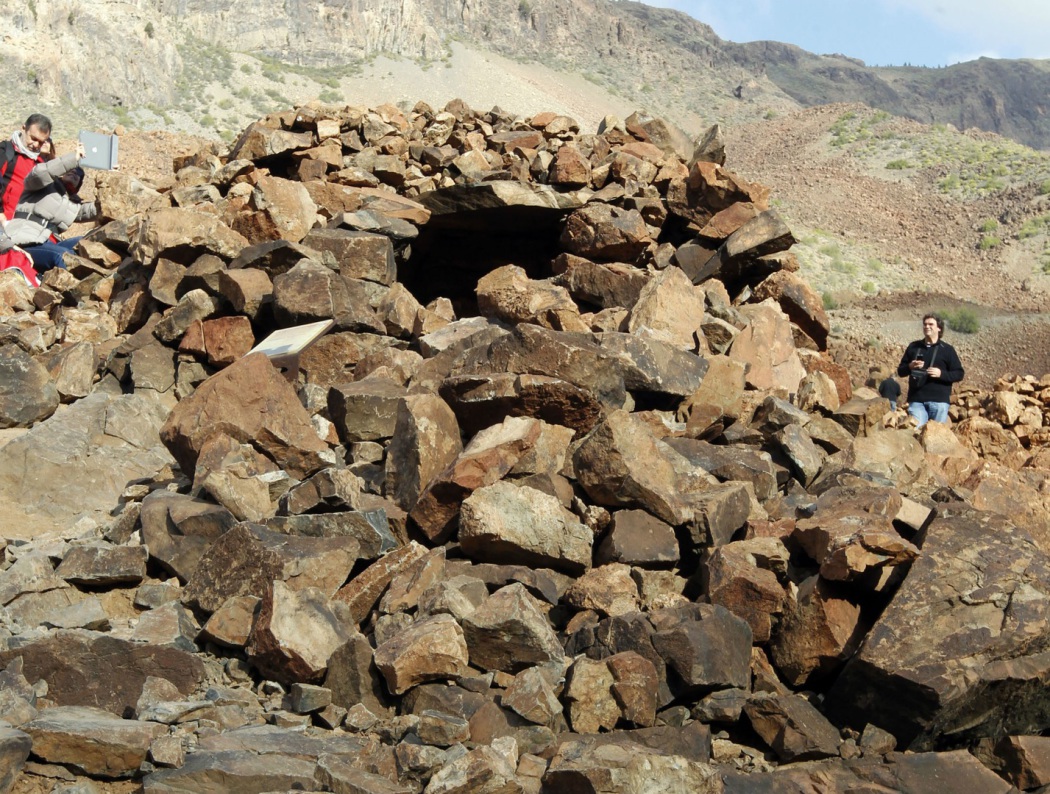Necrópolis de Artenara
La Necrópolis de Arteara es el cementerio aborigen de mayor entidad de la isla, tanto en extensión como en número de inhumaciones, ocupa un espacio de 137.570 m2 y alberga 809 estructuras tumulares, con enterramientos individuales y colectivos.
Se localiza sobre un malpaís que obedece a un apilamiento de fonolita procedente de una avalancha. Arteara ha sido también centro de estudios astronómicos, descubriéndose el extenso conocimiento que de los astros debían tener los antiguos canarios, hasta el punto de levantar el "Túmulo del Rey", en un lugar estratégico para que el sol lo ilumine justo en el día del equinoccio.
Está situado junto al caserío de Arteara, en un paraje al que el contraste entre el verde palmeral y la dureza de la roca le confiere una singular belleza. Desde la necrópolis se observan los impresionantes riscos de Amurga con paredes de hasta mil metros de altitud, lugar desde donde los días del equinoccio el sol ilumina al amanecer el "Túmulo del Rey".
Un Centro de Interpretación y el recorrido por la Necrópolis desvelarán al visitante la vida y la muerte de los antiguos canarios.
Octubre a marzo: martes a domingo de 10:00 a 17:00 h.
Abril a septiembre(*): martes a domingo de 10:00 a 18:00 h.
Permanece cerrado todos los lunes, los días 1, 5 y 6 de enero, 1 de mayo y 24, 25 y 31 de diciembre.
Horario de verano
*Del 14 de julio al 31 de agosto: martes a domingo de 10:00 a 14:00h.
Precio entrada
Precio general: 4 €. Esta entrada permite el acceso al recinto durante todo un año.
Precio reducido: 2 €: grupos de escolares (excepto los del Municipio) o grupos de más de 10 personas con visita previamente concertada; menores entre 10 y 14 años, titulares con carné de estudiante y mayores de 65 años.
Entrada especial gratuita: Grupos de centros educativos del Municipio con visita previamente concertada; guías turísticos y profesorado que acompañe a los grupos; menores de 10 años.
Para acogerse a la tarifa reducida debe acreditarse adecuadamente que se dan las condiciones para la aplicación del descuento.
Se ofrecen recorridos guiados, actividades y talleres para grupos de escolares o de particulares a partir de 10 integrantes.
Las visitas con guía han de ser concertadas previamente.
Municipio: San Bartolomé de Tirajana
Teléfono: (+34) 638 810 591
E-mail: necropolisdearteara@arqueocanaria.com
Web: www.necropolisdearteara.com
The Arteara Necropolis is the largest aboriginal cemetery of its kind on the island, both in terms of size and number of burial mounds there. It occupies an area of 137,570 m2 and houses 809 tomb structures, with both individual and collective burial mounds.
It is located on a malpaís, an arid, rocky area caused by the pile up of phonolite volcanic rock following an avalanch. Arteara has also been a centre for astronomical studies, revealing just what an extensive knowledge the Ancient Canarians must have had about the stars, to such an extent that they built the “King’s Tomb” in such a strategic place that the sun lit it up right on the day of the equinox.
It is located next to the tiny village of Arteara, on a site which contrasts a green palm grove with a rugged rocky terrain, making for a truly beautiful spot. From the necropolis visitors can also make out the amazing cliffs of Amurga whose steep walls rise up to over 1,000m altitude, at the spot where on days of the equinox the early morning sun will light up the “King’s Tomb”.
A Visitors Centre and a tour around the Necropolis will reveal all about the life and death of the Ancient Canarians.
October to March: Tuesday to Sunday from 10:00 to 17:00 h.
April to September(*): Tuesday to Sunday from 10:00 to 18:00 h.
Closed Mondays, and 1st, 5th and 6th January, 1st May, and 24th, 25th and 31st December.
Summer Opening Hours
*14th July to 31st August: Tuesday to Sunday from 10:00 to 14:00h.
Entrance fee
General price: 4 €. This price allows visitors access for a whole year.
Reduced price: 2 €. School groups (except local school) or groups of over 10 people with prior appointment; children between the ages of 10 and 14, student card holders, and over 65s.
Special free entry: Educational groups from the municipality with prior appointment; tourist guides and teachers accompanying groups; children under 10.
To qualify for the reduced fee, visitors must be able to produce all appropriate documentation.
Guided tours, activities and workshops are available to school groups or private groups of over 10 individuals.
Guided tours have to be requested by prior appointment by calling.
Location: Along GC-60 main road towards Fataga
Municipality: San Bartolomé de Tirajana
Telephone: (+34) 638 810 591
E-mail: necropolisdearteara@arqueocanaria.com
Web: www.necropolisdearteara.com
Die Nekropole von Arteara ist sowohl in der Ausdehnung wie auch der Gräberzahl die größte aborigine Begräbnisstätte der Insel Gran Canaria. Auf der 137.570 Quadratmeter umfassenden Fläche befinden sich 809 individuelle und kollektive Grabhügel.
Die Nekropole befindet sich in einer Einöde aus Phonolithgestein, das in einer Felslawine vom Vulkan herabfiel. Arteara war zudem ein Zentrum für astronomische Beobachtungen. Heute ist bekannt, dass das aborigine Volk ein eingehendes Wissen über die Sterne besaß. So wurde der Tumulus, der als das "Königsgrab" bekannt ist, an einer Stelle angelegt, die zur Tag-und-Nacht-Gleiche von der Sonne angestrahlt wird.
Die Nekropole liegt in der Nähe des Weilers Arteara in einer beeindruckenden Landschaft, deren grüne Palmenhaine einen faszinierenden Kontrast zum harten Felsgestein bilden. Über der Nekropole erheben sich die imposanten, beinahe 1000 Meter hohen Felshänge von Amurga. Über ihnen geht am Tag des Äquinoktiums die Sonne auf, deren Strahlen das Königsgrab beleuchten.
Das Besucherzentrum und der Rundgang über die Nekropole bieten interessante Einblicke in Leben und Tod der aboriginen Kanarier.
Oktober bis März: Dienstag bis Sonntag 10 - 17 Uhr
April bis September(*): Dienstag bis Sonntag 10 – 18 Uhr
*14. Juli bis 31. August: Dienstag bis Sonntag 10 - 14 Uhr
Das Museum ist montags und am 1., 5. und 6. Januar, 1. Mai, 24. sowie 25. und 31. Dezember geschlossen.
Eintritt
Allgemeiner Tarif: 4 €. Die Eintrittskarte bietet 1 Jahr Zutritt zur Anlage.
Reduzierter Tarif: 2 €. Schulgruppen (außer Gemeindeschulen) oder Gruppen über 10 Personen mit Voranmeldung, Kinder und Jugendliche von 10 – 14 Jahren, Studenten mit Ausweis und Senioren über 65 Jahre
Eintritt frei: Schulgruppen der Gemeinde mit Voranmeldung, Reiseführer und Lehrer in Begleitung von Gruppen, Kinder unter 10 Jahre
Für reduzierten Tarif ist die Vorlage einer Berechtigung erforderlich.
Geführte Rundgänge, Aktivitäten und Workshops für Schulgruppen und Gruppen ab 10 Personen.
Für geführte Rundgänge ist eine Voranmeldung erforderlich.
Adresse: Landstraße GC-60 nach Fataga
Gemeinde: San Bartolomé de Tirajana
Telefon: (+34) 638 810 591
E-mail: necropolisdearteara@arqueocanaria.com
Web: www.necropolisdearteara.com







